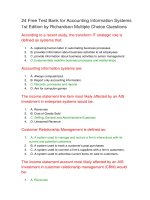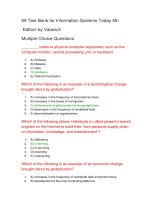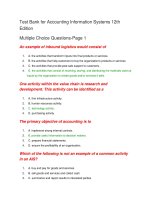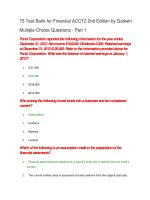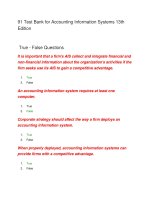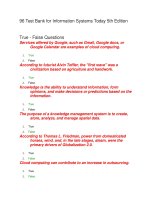TEST BANK ACCOUNTING INFORMATION SYSTEMS 2ND EDITION RICHARDSON CH02
Bạn đang xem bản rút gọn của tài liệu. Xem và tải ngay bản đầy đủ của tài liệu tại đây (481.19 KB, 19 trang )
Chapter 02
Accountants as Business Analysts
Answer Key
True / False Answers
1.
Accountants now face a challenge of helping businesses optimize processes.
Answer: True
AICPA: Analytic
AICPA BB: Leveraging Technology
AICPA FN: Leveraging Technology
Blooms: Remember
Difficulty: 1 Easy
Learning Objective: 02-01 Describe the roles of the accounting/finance function in business and why those roles require knowledge of technology
and business processes
Source: Original
Topic: Changing Roles of Accountants in Business
2.
To be valuable business partners, accountants must understand how the business delivers value
to its employees.
Answer: False
AICPA: Analytic
AICPA BB: Leveraging Technology
AICPA FN: Leveraging Technology
Blooms: Remember
Difficulty: 1 Easy
Learning Objective: 02-01 Describe the roles of the accounting/finance function in business and why those roles require knowledge of technology
and business processes
Source: Original
Topic: Changing Roles of Accountants in Business
3.
A business process constrains business rules.
Answer: False
4.
AICPA: Analytic
AICPA BB: Leveraging Technology
AICPA FN: Leveraging Technology
Blooms: Remember
Difficulty: 1 Easy
Learning Objective: 02-03 Recognize the value of business models
Source: Original
Topic: Value of Business Models
A business model is typically a graphical depiction of the essential business process information.
Answer: True
AICPA: Analytic
AICPA BB: Leveraging Technology
AICPA FN: Leveraging Technology
Blooms: Understand
Difficulty: 2 Medium
Learning Objective: 02-03 Recognize the value of business models
Source: Original
Topic: Value of Business Models
5.
Documentation can be thought of as a tool for information transmission and communication.
Answer: True
6.
Documentation helps with training but won’t help with regulatory compliance issues.
Answer: False
7.
AICPA: Analytic
AICPA BB: Leveraging Technology
AICPA FN: Leveraging Technology
Blooms: Understand
Difficulty: 2 Medium
Learning Objective: 02-03 Recognize the value of business models
Source: Original
Topic: Value of Business Models
Because business models are simpler than the processes they depict, they are limited in their
ability to integrate local views of a process.
Answer: False
9.
AICPA: Analytic
AICPA BB: Leveraging Technology
AICPA FN: Leveraging Technology
Blooms: Understand
Difficulty: 2 Medium
Learning Objective: 02-02 Understand the importance of business process documentation
Source: Original
Topic: Business Process Documentation
Models should be simpler than the processes and systems they depict.
Answer: True
8.
AICPA: Analytic
AICPA BB: Leveraging Technology
AICPA FN: Leveraging Technology
Blooms: Understand
Difficulty: 2 Medium
Learning Objective: 02-02 Understand the importance of business process documentation
Source: Original
Topic: Business Process Documentation
AICPA: Analytic
AICPA BB: Leveraging Technology
AICPA FN: Leveraging Technology
Blooms: Understand
Difficulty: 2 Medium
Learning Objective: 02-03 Recognize the value of business models
Source: Original
Topic: Value of Business Models
Activity models are a relatively new process modeling tool.
Answer: False
AICPA: Analytic
AICPA BB: Leveraging Technology
AICPA FN: Leveraging Technology
Blooms: Remember
Difficulty: 1 Easy
Learning Objective: 02-04 Articulate the characteristics of activity models
Source: Original
Topic: Characteristics of Activity Models
10.
In Business Process Modeling Notation (BPMN), activities are named with a short verb phrase
placed within the rectangle.
Answer: True
11.
Business Process Modeling Notation (BPMN) activity models typically show the sequence of
flow from right to left and top to bottom.
Answer: False
12.
AICPA: Analytic
AICPA BB: Leveraging Technology
AICPA FN: Leveraging Technology
Blooms: Remember
Difficulty: 1 Easy
Learning Objective: 02-05 Understand and apply the building blocks for BPMN (activity) diagrams
Source: Original
Topic: Business Process Modeling Notation
Business Process Modeling Notation (BPMN) activity diagrams depict activities as circles.
Answer: False
14.
AICPA: Analytic
AICPA BB: Leveraging Technology
AICPA FN: Leveraging Technology
Blooms: Remember
Difficulty: 1 Easy
Learning Objective: 02-04 Articulate the characteristics of activity models
Source: Original
Topic: Characteristics of Activity Models
Business Process Modeling Notation (BPMN) activity diagrams depict events as circles.
Answer: True
13.
AICPA: Analytic
AICPA BB: Leveraging Technology
AICPA FN: Leveraging Technology
Blooms: Remember
Difficulty: 1 Easy
Learning Objective: 02-04 Articulate the characteristics of activity models
Source: Original
Topic: Characteristics of Activity Models
AICPA: Analytic
AICPA BB: Leveraging Technology
AICPA FN: Leveraging Technology
Blooms: Remember
Difficulty: 1 Easy
Learning Objective: 02-05 Understand and apply the building blocks for BPMN (activity) diagrams
Source: Original
Topic: Business Process Modeling Notation
An activity can depict a single action or some logical combination of actions depending on the
required level of detail to achieve the objectives of the business process analysis.
Answer: True
15.
Gateways only show decisions and possible branching as a result of the decision.
Answer: False
16.
AICPA: Analytic
AICPA BB: Leveraging Technology
AICPA FN: Leveraging Technology
Blooms: Remember
Difficulty: 1 Easy
Learning Objective: 02-05 Understand and apply the building blocks for BPMN (activity) diagrams
Source: Original
Topic: Business Process Modeling Notation
Business Process Modeling Notation (BPMN) activity diagrams are conceptually similar to
process maps.
Answer: True
18.
AICPA: Analytic
AICPA BB: Leveraging Technology
AICPA FN: Leveraging Technology
Blooms: Understand
Difficulty: 2 Medium
Learning Objective: 02-05 Understand and apply the building blocks for BPMN (activity) diagrams
Source: Original
Topic: Business Process Modeling Notation
Swimlanes (or lanes) identify participants, e.g., functions or departments, in a process.
Answer: True
17.
AICPA: Analytic
AICPA BB: Leveraging Technology
AICPA FN: Leveraging Technology
Blooms: Understand
Difficulty: 2 Medium
Learning Objective: 02-05 Understand and apply the building blocks for BPMN (activity) diagrams
Source: Original
Topic: Business Process Modeling Notation
AICPA: Analytic
AICPA BB: Leveraging Technology
AICPA FN: Leveraging Technology
Blooms: Remember
Difficulty: 2 Medium
Learning Objective: 02-05 Understand and apply the building blocks for BPMN (activity) diagrams
Source: Original
Topic: Business Process Modeling Notation
Business Process Modeling Notation (BPMN) start events are shown using ovals and flowchart
start events are shown using circles.
Answer: False
AICPA: Analytic
AICPA BB: Leveraging Technology
AICPA FN: Leveraging Technology
Blooms: Remember
Difficulty: 1 Easy
Learning Objective: 02-05 Understand and apply the building blocks for BPMN (activity) diagrams
Source: Original
Topic: Business Process Modeling Notation
19.
Opportunity flowcharts identify opportunities for process improvement by separating valueadded from non-value-added activities.
Answer: True
20.
AICPA: Analytic
AICPA BB: Leveraging Technology
AICPA FN: Leveraging Technology
Blooms: Understand
Difficulty: 2 Medium
Learning Objective: 02-04 Articulate the characteristics of activity models
Source: Original
Topic: Characteristics of Activity Models
Data Flow Diagrams start with a circle indicating the start event.
Answer: False
AICPA: Analytic
AICPA BB: Leveraging Technology
AICPA FN: Leveraging Technology
Blooms: Remember
Difficulty: 1 Easy
Learning Objective: 02-04 Articulate the characteristics of activity models
Source: Original
Topic: Characteristics of Activity Models
Multiple Choice Answers
21.
Which of the following is not a Stewardship and Reporting role of the Accounting/Finance
Function in Business?
A. Human Resource management
B. Regulatory compliance
C. Tax returns
D. Statutory reporting
AICPA: Analytic
AICPA BB: Leveraging Technology
AICPA FN: Leveraging Technology
Blooms: Remember
Difficulty: 1 Easy
Learning Objective: 02-01 Describe the roles of the accounting/finance function in business and why those roles require knowledge of technology
and business processes
Source: Original
Topic: Changing Roles of Accountants in Business
22.
Which of the following is not a Business Management Support role of the Accounting/Finance
Function in Business?
A. Management information
B. Planning, budgeting and forecasting
C. Financial consolidation, reporting and analysis
D. Investment appraisal
AICPA: Analytic
AICPA BB: Leveraging Technology
AICPA FN: Leveraging Technology
Blooms: Remember
Difficulty: 1 Easy
Learning Objective: 02-01 Describe the roles of the accounting/finance function in business and why those roles require knowledge of technology
and business processes
Source: Original
Topic: Changing Roles of Accountants in Business
23.
Which of the following is not an Accounting/Finance Operations role of the Accounting/Finance
Function in Business?
A. Financial close – completing period end accounts
B. Stakeholder assurance
C. People management
D. Financial consolidation, reporting and analysis
AICPA: Analytic
AICPA BB: Leveraging Technology
AICPA FN: Leveraging Technology
Blooms: Remember
Difficulty: 1 Easy
Learning Objective: 02-01 Describe the roles of the accounting/finance function in business and why those roles require knowledge of technology
and business processes
Source: Original
Topic: Changing Roles of Accountants in Business
24.
Which of the following is not part of the business analysis process?
A. Ascertaining information about current and future business processes.
B. Using business process modeling tools.
C. Using IT to make finance and accounting processes more efficient and effective.
D. Documenting current and future business processes.
AICPA: Analytic
AICPA BB: Leveraging Technology
AICPA FN: Leveraging Technology
Blooms: Understand
Difficulty: 2 Medium
Learning Objective: 02-02 Understand the importance of business process documentation
Source: Original
Topic: Business Process Documentation
25.
Which of the following best describes a business model?
A. A simple, abstract representation of a business process or processes.
B. A sequence of business activities.
C. An evaluation of potential business process improvements.
D. None of the above.
AICPA: Analytic
AICPA BB: Leveraging Technology
AICPA FN: Leveraging Technology
Blooms: Understand
Difficulty: 2 Medium
Learning Objective: 02-03 Recognize the value of business models
Source: Original
Topic: Value of Business Models
26.
Process documentation does not include which of the following?
A. Process models
B. Business rules
C. User manuals
D. External audit workpapers
AICPA: Analytic
AICPA BB: Leveraging Technology
AICPA FN: Leveraging Technology
Blooms: Understand
Difficulty: 2 Medium
Learning Objective: 02-02 Understand the importance of business process documentation
Source: Original
Topic: Business Process Documentation
27.
Which of the following is not a purpose of documentation?
A. Training
B. Determining staffing
C. Describing current processes
D. Establishing accountability
AICPA: Analytic
AICPA BB: Leveraging Technology
AICPA FN: Leveraging Technology
Blooms: Understand
Difficulty: 2 Medium
Learning Objective: 02-02 Understand the importance of business process documentation
Source: Original
Topic: Business Process Documentation
28.
Business models provide value in all of the following areas except which one?
A. Employee performance appraisal
B. Managing complexity
C. Specifying systems requirements
D. Eliciting requirements for new systems
AICPA: Analytic
AICPA BB: Leveraging Technology
AICPA FN: Leveraging Technology
Blooms: Understand
Difficulty: 2 Medium
Learning Objective: 02-03 Recognize the value of business models
Source: Original
Topic: Value of Business Models
29.
Which of the following best describes the purpose of an activity model?
A. An activity model describes the sequence of workflow in a business process.
B. An activity model constrains and guides process operations.
C. An activity model depicts data structures.
D. None of the above.
AICPA: Analytic
AICPA BB: Leveraging Technology
AICPA FN: Leveraging Technology
Blooms: Understand
Difficulty: 2 Medium
Learning Objective: 02-04 Articulate the characteristics of activity models
Source: Original
Topic: Characteristics of Activity Models
30.
Which of the following is not a common element of activity models regardless of the specific
modeling notation?
A. Events to start and stop the workflow
B. Sequence of flow between tasks
C. Multiplicities
D. Decision points that affect the process flow
AICPA: Analytic
AICPA BB: Leveraging Technology
AICPA FN: Leveraging Technology
Blooms: Understand
Difficulty: 2 Medium
Learning Objective: 02-04 Articulate the characteristics of activity models
Source: Original
Topic: Characteristics of Activity Models
31.
Which of the following is not a building block for Business Process Modeling Notation (BPMN)
diagrams?
A. Associations
B. Events
C. Gateways
D. Sequence flows
AICPA: Analytic
AICPA BB: Leveraging Technology
AICPA FN: Leveraging Technology
Blooms: Understand
Difficulty: 2 Medium
Learning Objective: 02-05 Understand and apply the building blocks for BPMN (activity) diagrams
Source: Original
Topic: Business Process Modeling Notation
32.
Which of the following best describes the purpose of an event in a Business Process Modeling
Notation (BPMN) activity diagram?
A. Shows where the work takes place.
B. Describes the sequence of workflow.
C. Affects the flow of the business process.
D. Controls branching and merging.
AICPA: Analytic
AICPA BB: Leveraging Technology
AICPA FN: Leveraging Technology
Blooms: Understand
Difficulty: 2 Medium
Learning Objective: 02-05 Understand and apply the building blocks for BPMN (activity) diagrams
Source: Original
Topic: Business Process Modeling Notation
33.
Which of the following best describes the purpose of a gateway in a Business Process Modeling
Notation (BPMN) activity diagram?
A. Shows where the work takes place.
B. Describes the sequence of workflow.
C. Affects the flow of the business process.
D. Controls branching and merging.
AICPA: Analytic
AICPA BB: Leveraging Technology
AICPA FN: Leveraging Technology
Blooms: Understand
Difficulty: 2 Medium
Learning Objective: 02-05 Understand and apply the building blocks for BPMN (activity) diagrams
Source: Original
Topic: Business Process Modeling Notation
34.
Which of the following symbols depicts an intermediate event?
A.
B.
C.
D.
35.
An arrow
A circle with a double line perimeter
A rectangle
A circle with a wide single line perimeter
AICPA: Analytic
AICPA BB: Leveraging Technology
AICPA FN: Leveraging Technology
Blooms: Understand
Difficulty: 2 Medium
Learning Objective: 02-05 Understand and apply the building blocks for BPMN (activity) diagrams
Source: Original
Topic: Business Process Modeling Notation
Which of the following symbols depicts an activity?
A. An arrow
B. A circle with a double line perimeter
C. A rectangle
D. A circle with a wide single line perimeter
AICPA: Analytic
AICPA BB: Leveraging Technology
AICPA FN: Leveraging Technology
Blooms: Understand
Difficulty: 2 Medium
Learning Objective: 02-05 Understand and apply the building blocks for BPMN (activity) diagrams
Source: Original
Topic: Business Process Modeling Notation
36.
Which of the following symbols is used to depict different organizations in one Business Process
Modeling Notation (BPMN) diagram?
A. Gateway
B. Message flow
C. Pool
D. Intermediate event
AICPA: Analytic
AICPA BB: Leveraging Technology
AICPA FN: Leveraging Technology
Blooms: Understand
Difficulty: 2 Medium
Learning Objective: 02-05 Understand and apply the building blocks for BPMN (activity) diagrams
Source: Original
Topic: Business Process Modeling Notation
37.
Which of the following best describes the purpose of swimlanes (or lanes)?
A. Depict different organizations involved in a process.
B. Depict different departments of the same organization in a process.
C. Depict interactions between organizations in a process.
D. Depict the sequence of tasks in a process.
AICPA: Analytic
AICPA BB: Leveraging Technology
AICPA FN: Leveraging Technology
Blooms: Understand
Difficulty: 2 Medium
Learning Objective: 02-05 Understand and apply the building blocks for BPMN (activity) diagrams
Source: Original
Topic: Business Process Modeling Notation
38.
Which of the following best describes a Business Process Modeling Notation (BPMN) message
flow?
A. Shows the sequence of activities in a process.
B. Shows interactions between participants in a process.
C. Affects the flow of a business process.
D. Shows branching and merging in a business process.
AICPA: Analytic
AICPA BB: Leveraging Technology
AICPA FN: Leveraging Technology
Blooms: Understand
Difficulty: 2 Medium
Learning Objective: 02-05 Understand and apply the building blocks for BPMN (activity) diagrams
Source: Original
Topic: Business Process Modeling Notation
39.
Which of the following best describes the difference between a Business Process Modeling
Notation (BPMN) gateway and a flowcharting decision diamond?
A. Only the decision diamond shows branching of the sequence flow.
B. The gateway ony represents branching and not the decision that results in branching.
C. Only the gateway shows branching of the sequence flow.
D. The decision diamond can depict more branching options.
AICPA: Analytic
AICPA BB: Leveraging Technology
AICPA FN: Leveraging Technology
Blooms: Understand
Difficulty: 2 Medium
Learning Objective: 02-05 Understand and apply the building blocks for BPMN (activity) diagrams
Source: Original
Topic: Business Process Modeling Notation
40.
Which of the following is a difference between Business Process Modeling Notation (BPMN)
activity diagrams and flowcharts?
A. BPMN symbols can show a variety of intermediate events that affect the sequence flow.
B. Flowcharts have symbols to represent the start and end of a process.
C. BPMN diagrams show the sequence flow of activities.
D. Flowcharts can be annotated with text.
AICPA: Analytic
AICPA BB: Leveraging Technology
AICPA FN: Leveraging Technology
Blooms: Understand
Difficulty: 2 Medium
Learning Objective: 02-05 Understand and apply the building blocks for BPMN (activity) diagrams
Source: Original
Topic: Business Process Modeling Notation
41.
In order to perform their required roles and be valuable business partners, accountants must
understand all of the following except:
E. How the business identifies and designs its products and services
F. How the business collects data, summarizes it, and communicates business information
G. How the business delivers value, interacts with other businesses, and is a good corporate
citizen
H. What risks the business faces, and how internal controls can mitigate those risks
AICPA: Analytic
AICPA BB: Leveraging Technology
AICPA FN: Leveraging Technology
Blooms: Remember
Difficulty: 1 Easy
Learning Objective: 02-01 Describe the roles of the accounting/finance function in business and why those roles require knowledge of technology
and business processes
Source: Original
Topic: Changing Roles of Accountants in Business
42.
Which of the following best describes why the Sarbanes-Oxley Act of 2002 (SOX) made
documentation of business processes essential for businesses?
E. SOX mandates that accountants create the business rules and documenation associated with a
company’s business processes
F. SOX requires managers to assess and attest to the company’s internal controls structures
and procedures
G. SOX explicitly states that business processes must be documented
H. SOX allows thorough documentation of business processes to act as a substitute for a full
review of internal control structures and procedures
AICPA: Analytic
AICPA BB: Leveraging Technology
AICPA FN: Leveraging Technology
Blooms: Remember
Difficulty: 1 Easy
Learning Objective: 02-02 Understand the importance of business process documentation.
Source: Original
Topic: Business Process Documentation
43.
Which of the following best describes how business models help companies manage
complexity?
A. Because business models can’t exceed one page, managers can understand how the business
works at a glance.
B. Although business models are a simplification of the actual processes they represent, they
incorporate the processes’ essential elements.
C. Business models’ limitations force managers to simplify the company’s actual processes.
D. Business models must display every detailed task and activity, which allows managers to
visualize the complexity inherent in its business processes.
AICPA: Analytic
AICPA BB: Leveraging Technology
AICPA FN: Leveraging Technology
Blooms: Remember
Difficulty: 1 Easy
Learning Objective: 02-03 Recognize the value of business models.
Source: Original
Topic: Value of Business Models
44.
Activity models are analagous to which of the following?
A. The prototype for a new car model
B. A blueprint
C. The instructions in a recipe
D. A car’s steering system
AICPA: Analytic
AICPA BB: Leveraging Technology
AICPA FN: Leveraging Technology
Blooms: Remember
Difficulty: 1 Easy
Learning Objective: 02-04 Articulate the characteristics of activity models.
Source: Original
Topic: Characteristics of Activity Models
45.
When creating a BPMN activity model, which of the following is most accurate?
E. Modeling is an artistic endeavor; therefore different modelers given the same set of facts
about a business process will likely develop very different models of the process.
F. The resulting BPMN activity model should closely match the structure of the subsequent
database.
G. All activity models should include gateways.
H. Different modelers given the same set of facts about a busines process should develop
similar models of the process.
AICPA: Analytic
AICPA BB: Leveraging Technology
AICPA FN: Leveraging Technology
Blooms: Remember
Difficulty: 1 Easy
Learning Objective: 02-05 Understand and apply the building blocks for BPMN (activity) diagrams.
Source: Original
Topic: Business Process Modeling Notation
46.
A pool in a BPMN activity model represents:
A. An entire organization/entity.
B. A department or functional area.
C. A specific individual.
D. A logical activity.
AICPA: Analytic
AICPA BB: Leveraging Technology
AICPA FN: Leveraging Technology
Blooms: Remember
Difficulty: 1 Easy
Learning Objective: 02-06 Use pools and lanes to identify process participants.
Source: Original
Topic: Identifying Participants in Business Process Diagrams
47.
Message flows in BPMN activity diagrams indicate an exchange between:
A. Activities in the same swimlane
B. Participants in different pools
C. Gateways in different swimlanes
D. Events in the same pool
AICPA: Analytic
AICPA BB: Leveraging Technology
AICPA FN: Leveraging Technology
Blooms: Remember
Difficulty: 1 Easy
Learning Objective: 02-07 Apply message flows to show interactions between pools.
Source: Original
Topic: Messages in BPMN
48.
When connecting to an opaque external pool in a BPMN activity diagram, message flows
connect to:
A. The edge of the opaque pool.
B. The edge of the swimlane.
C. The nearest sequence flow.
D. The appropriate data store.
AICPA: Analytic
AICPA BB: Leveraging Technology
AICPA FN: Leveraging Technology
Blooms: Remember
Difficulty: 1 Easy
Learning Objective: 02-07 Apply message flows to show interactions between pools.
Source: Original
Topic: Messages in BPMN
49.
Which of the following is not a valid BPMN gateway type?
A. Parallel gateway
B. Serial gateway
C. Inclusive gateway
D. Exclusive gateway
AICPA: Analytic
AICPA BB: Leveraging Technology
AICPA FN: Leveraging Technology
Blooms: Remember
Difficulty: 1 Easy
Learning Objective: 02-08 Understand and apply flow object types
Source: Original
Topic: Extended Building Blocks for BPMN Diagrams and Modeling Concepts
50.
Which of the following BPMN shapes represents a Parallel Gateway?
A.
B.
Correct
C.
D.
AICPA: Analytic
AICPA BB: Leveraging Technology
AICPA FN: Leveraging Technology
Blooms: Remember
Difficulty: 1 Easy
Learning Objective: 02-08 Understand and apply flow object types
Source: Original
Topic: Extended Building Blocks for BPMN Diagrams and Modeling Concepts
51.
Which of the following BPMN shapes represents an Error Event?
A.
B.
C.
D.
Correct
AICPA: Analytic
AICPA BB: Leveraging Technology
AICPA FN: Leveraging Technology
Blooms: Remember
Difficulty: 1 Easy
Learning Objective: 02-08 Understand and apply flow object types
Source: Original
Topic: Extended Building Blocks for BPMN Diagrams and Modeling Concepts
52.
A boundary event in a BPMN activity model:
A. Takes place at the edge of a swimlane
B. Occurs at the border of a pool.
C. Is attached to the edge of an activity.
D. Occurs as a message leaves a pool.
AICPA: Analytic
AICPA BB: Leveraging Technology
AICPA FN: Leveraging Technology
Blooms: Remember
Difficulty: 1 Easy
Learning Objective: 02-08 Understand and apply flow object types
Source: Original
Topic: Extended Building Blocks for BPMN Diagrams and Modeling Concepts
53.
Which of the following BPMN shapes represents a parallel multi-instance task?
A.
B.
Correct
C.
D.
54.
AICPA: Analytic
AICPA BB: Leveraging Technology
AICPA FN: Leveraging Technology
Blooms: Remember
Difficulty: 1 Easy
Learning Objective: 02-09 Recognize and model repeating activities.
Source: Original
Topic: Subprocesses and Repeating Activities
Which of the following BPMN shapes represents a data object?
A.
B.
C.
Correct
D.
AICPA: Analytic
AICPA BB: Leveraging Technology
AICPA FN: Leveraging Technology
Blooms: Remember
Difficulty: 1 Easy
Learning Objective: 02-10 Understand and apply data objects and stores to model data created, updated, transferred, and deleted in a process.
Source: Original
Topic: Data Objects, Data Stores, and Associations
55.
Which of the following BPMN shapes represents a data store?
A.
B.
C.
D.
Correct
AICPA: Analytic
AICPA BB: Leveraging Technology
AICPA FN: Leveraging Technology
Blooms: Remember
Difficulty: 1 Easy
Learning Objective: 02-10 Understand and apply data objects and stores to model data created, updated, transferred, and deleted in a process.
Source: Original
Topic: Data Objects, Data Stores, and Associations
Essay Answers
56. Use the following description to create a Business Process Modeling Notation (BPMN) activity
diagram of Nora’s process.
Nora accesses the Amazon.com website to purchase a favorite musician’s latest album. She searches for
the musician’s name. Amazon displays the results of the search, and she selects the correct entry. She
samples the music and then decides whether to purchase the album. If she decides to purchase the
album, then she must decide whether to purchase a physical CD or just download the MP3 files.
If she decides to purchase the CD, she clicks on the buy now button. Since she is an Amazon Prime
member, she automatically receives free 2-day delivery and the item is charged to her credit card. She
then waits 2 days for the delivery of the CD. When it arrives, she can enjoy the music.
If she decides to purchase the MP3, she selects that option and again clicks on the buy now button. She
is charged for the item and taken to a page to download her music. She downloads the album, and then
she can enjoy her music.
Answer: There could be several similar answers, but this is a basic solution:
AICPA: Analytic
AICPA BB: Leveraging Technology
AICPA FN: Leveraging Technology
Blooms: Apply
Difficulty: 3 Hard
Learning Objective: 02-05 Understand and apply the building blocks for BPMN (activity) diagrams
Source: Original
Topic: Business Process Modeling Notation
57.
Use the following description to create a Business Process Modeling Notation (BPMN) activity
diagram of Jeremy’s process.
Jeremy is using his bank’s online banking site to pay for his new phone. He logs onto the bank’s website
by entering his user name and password, confirming his SiteKey. After access to his account, he selects
the Bill Pay tab. He searches to see of the phone company is already listed in the “Pay To Accounts.”
If the phone company is not listed, he clicks on the option to “Add a New Pay To Account.” He fills in the
information for the phone company, including the name, address, account number, and phone number.
After completing the entry, he is taken back to the list of “Pay To Accounts.”
If the phone company is listed (or if he just completed entering the new account), he enters the amount
of the payment. Then, he selects the option to set up a recurring payment. He enters the number of
payments. Then, he selects the date that the payment should be sent each month. He then logs out of
the banks online banking site and closes his browser.
Answer: There could be several similar answers, but this is a basic solution:
AICPA: Analytic
AICPA BB: Leveraging Technology
AICPA FN: Leveraging Technology
Blooms: Apply
Difficulty: 3 Hard
Learning Objective: 02-05 Understand and apply the building blocks for BPMN (activity) diagrams
Source: Original
Topic: Business Process Modeling Notation
58.
Use the following description to create a Business Process Modeling Notation (BPMN) activity
diagram of Caitlin’s process.
Caitlin is planning to run in the local July 4 th 5K run. She wants to register online, but she forgot the
websites URL. So, she navigates to Google and starts a search for the site. She selects the registration site
from the search results. Once at the site, she selects the option to register for the 4 th of July run. She fills
in the registration form and provides her credit card information for payment.
After completing her own registration, she decides to register the other members of her team. One-byone, she enters the registration information for the team member and pays for their entry. After
completing all the registrations, she provides a user name and password so she can return to the site to
see their results after the race. She logs out of the site and closes her browser.
Answer: There could be several similar answers, but this is a basic solution:
AICPA: Analytic
AICPA BB: Leveraging Technology
AICPA FN: Leveraging Technology
Blooms: Apply
Difficulty: 3 Hard
Learning Objective: 02-05 Understand and apply the building blocks for BPMN (activity) diagrams
Source: Original
Topic: Business Process Modeling Notation
